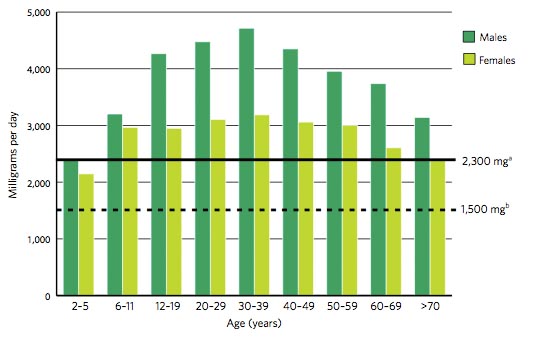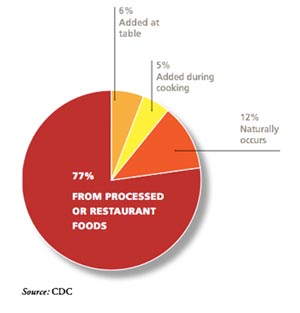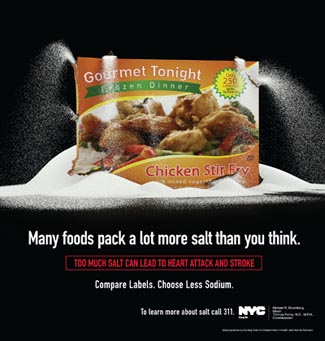Center for Communications, Health and the Environment

Sodium Rising:
High Sodium Intakes Compromise Health, Compel Consumption Cut
Written in conjunction with the staff of the Center for Science in the Public Interest
The 2010 Dietary Guidelines for Americans (DGA) task the population to lower its daily sodium intake, and to compare foods and choose those with lower sodium contents. And with good reason.
Eating less salt is one of the single best ways to prevent high blood pressure, heart attacks and strokes. Yet, despite decades of pressure by groups like Center for Science in the Public Interest (CSPI) and admonitions by prominent health experts, per capita sodium consumption has risen, and continues to increase.
Applying the adequate and tolerable intake levels developed by the Institute of Medicine (IOM), the current DGA recommend that individuals 14 years and older consume no more than 2,300 milligrams (mg) of sodium a day (about a teaspoon of salt), while people with hypertension, diabetes or chronic kidney disease, those who are 51 years and older, African Americans and children 9 to 14 consume no more than 1,500 mg of sodium daily. This 1,500 mg recommendation applies to about half of the U.S. population. Meanwhile, children ages 4 to 8 are advised to consume no more than 1,200 mg of sodium a day, and children ages 1 to 3 no more than 1,000 mg.
 |
Estimated Mean Daily Sodium Intake, by Age-Gender Group, NHANES 2005-2006. Consumption is well above the 2,300 mg/day Tolerable Upper Intake Level for individuals 14 years and older set by the Institute of Medicine, and the 1,500 mg/day Adequate Intake Level for individuals ages 9 years and older. (Source: DGA 2010, Figure 3-1) |
In fact, virtually all Americans consume more sodium than they need – about twice the recommended levels – and that’s the case for most people around the world. The National Cancer Institute’s 2005-2006 National Health and Nutrition Examination Survey (NHANES) found that average estimated daily sodium consumption was about 3,400 mg for adults, with children also grossly over-consuming the mineral (see chart). Actual daily intake, however, is probably even higher – closer to 4,000 mg/day for adults – since NHANES estimates omit salt added at the table or in cooking, and survey respondents often underestimate their actual consumption.
The Scoop on Salt
 |
Most of the average person's sodium intake in industrialized countries comes from processed or restaurant foods. (Graphic design source: Harvard Public Health Review, Fall 2009) |
Contrary to popular belief, most of the sodium populations in industrialized countries consume is not from the salt shaker. Three-quarters of all sodium comes from processed and restaurant foods. Many restaurant meals, especially at table-service restaurants, provide huge amounts of sodium – mostly from salt – in a single meal. At Applebee’s, for example, a meal of Sizzling Shrimp Skillet Fajitas and accompanying sides contains 5,310 mg of sodium; and while their Weight Watchers® Chipotle Lime Chicken with sides may pack only 490 calories, it shocks the system with 4,990 mg of sodium. At Red Lobster restaurants, the Admiral’s Feast alone contains 4,300 mg of sodium. Add in a Caesar Salad, a Cheddar Bay Biscuit and a Light Lemonade, and dinner delivers 5,265 mg – more sodium than is safe for most people to consume in three days!
Even some foods purchased at the grocery store have unsafe levels of salt. A Swanson Hungry Man Roasted Carved Turkey frozen dinner contains 1,620 mg of sodium. And some foods intended for children, like an Oscar Mayer Lunchables with Lean Ham and Cheddar Cracker Stackers, has more than 1,000 mg of sodium – nearly an entire day’s worth for kids ages 4 to 8.
But everyday foods such as bread also add up to surprisingly large amounts of sodium – not because they are salt-laden, but because people consume such foods frequently. In fact, yeast breads, including white bread/rolls, mixed-grain bread, flavored bread, whole-wheat bread/rolls, bagels, flat breads, croissants and English muffins, contribute 7 percent of the sodium in the U.S. diet, based on data from the 2005–2006 NHANES. Meanwhile, chicken naturally contains little sodium, but the ways in which it is both packaged and prepared often add tons of salt to an otherwise low-sodium option.
According to the DGA, “...calorie intake is associated with sodium intake (i.e., the more foods and beverages people consume, the more sodium they tend to consume).” So limiting calorie consumption can help reduce sodium intake, although this is not a given, as in the case of Applebee’s Weight Watchers® Chipotle Lime Chicken dinner.
Reasons to Reduce
The extraordinary importance of lowering sodium consumption has become a hot-button issue of the current millennium. It was highlighted in a 2004 commentary in the American Journal of Public Health coauthored by Claude Lenfant, then-director of the National Heart, Lung and Blood Institute, and two colleagues. The article estimated that reducing the sodium content of packaged and restaurant foods in the United States by 50 percent would prevent 150,000 deaths per year from cardiovascular disease.
Lowering sodium consumption also would save tens of billions of dollars in annual healthcare costs. A 2009 RAND Corporation study estimates that reducing average sodium intake from 3,400 to 2,300 mg per day would reduce direct medical costs by $18 billion per year. And a further reduction to 1,500 mg per day could cut medical costs by $28 billion annually. Because hypertension is a major cause of disease and death in most countries around the world, similar benefits due to lowering sodium consumption would accrue to most nations.
Here Today, Here Tomorrow?
While more prominent today, the case to lower sodium levels is not new. In the early 1980s, the U.S. Food and Drug Administration (FDA) called for vigorous voluntary action on the part of industry to cut salt. But when CSPI evaluated the changes in almost 100 foods produced in 1983 and still made in 2004, the sodium content of those foods decreased an average of only 5 percent, a decline of 0.3 percent per year – a far lower rate than needed to achieve the 50-percent reduction over 10 years that the American Medical Association, American Heart Association, American Public Health Association and many other experts have recommended.
That said, with many restaurants now making their nutritional information publicly available, sodium levels may finally be dipping. For example, Red Lobster’s above-mentioned Admiral’s Feast, Caesar Salad, Cheddar Bay Biscuit and Light Lemonade previously packed 6,555 mg of sodium, 1,290 mg more than it does today. Perhaps, the food industry is getting the message (or adjusting portion sizes to deliver the difference).
National Programs and Mandatory Measures
In contrast to the U.S. government’s spotty track record on sodium reform, the United Kingdom’s Food Standards Agency has successfully made salt reduction a top priority and is both making consumers more aware of the health threat posed by excessive salt consumption and exerting strong pressure on the food and restaurant industries to gradually lower sodium levels to specified targets. U.K. food makers have reduced salt levels by 40 percent or more in some products; it is unclear, however, whether the British government will continue to support this initiative under Prime Minister David Cameron.
 |
New York City has taken the lead in battling salt nationwide. Above, a subway poster from the Big Apple's 2010 Salt Media Campaign. (Source: http://www.nyc.gov/html/doh/html/cardio/cardio-salt-ads.shtml)
|
Meanwhile, America’s biggest hope for widespread sodium reduction rests on the National Salt Reduction Initiative (NSRI). Based upon the U.K.’s Salt Reduction Campaign, the NSRI is a coalition of 72 local and state health authorities and health organizations working to help food manufacturers and restaurants voluntarily reduce the amount of salt in their products. The goal of the NSRI is to reduce sodium intake by 20 percent over five years, by cutting the salt in packaged and restaurant foods by 25 percent during that time. Spearheaded by the New York City (NYC) Health Department, it is currently led by NYC health officials, who, after receiving input from industry, in April 2010, announced final targets for 62 categories of packaged food and 25 categories of restaurant food. To date, 28 food manufacturers and restaurant chains have committed to the NSRI sodium targets, including Campbell Soup Company, Kraft Foods, Au Bon Pain, Starbucks Coffee Company, Unilever and Target Corporation.
Other companies (including major ones such as ConAgra, Pepperidge Farms and Frito-Lay) have also committed to reducing sodium on their own accord by about 10 to 25 percent over the next several years.
To ensure that all food manufacturers and restaurant chains reduce sodium in their foods, the FDA needs to take action and set mandatory limits on salt, which could be phased in gradually over time. This is exactly what a landmark IOM report on strategies to reduce sodium called for in April 2010. Mandatory measures are also likely to be necessary in other countries that are experiencing unnecessarily high rates of cardiovascular disease due to excess dietary salt.
Sodium reduction should be a top health priority for governments around the world. The new dietary guidelines have upped the ante in America, and CSPI will continue to urge the U.S. government and the food industry to cut sodium; but health advocates will be the key to measures that are truly “worth their salt” at reducing sodium levels both in the United States and around the world.
Read More:
Lead Article: Dietary Guidelines 2010 Focus on Obesity, Call for Reduced Sodium, Fat and Sugar Intake
Spotlight Article: High Sodium Intakes Compromise Health, Compel Consumption Cut
CECHE News: Pressure to “Dump Soda” Prompts Pepsi Pull-out from Schools Worldwide

Dr. Sushma Palmer, Program Director
Valeska Stupak, Editor & Design Consultant
Shiraz Mahyera, Systems Manager
Daniel Hollingsworth, Website Consultant